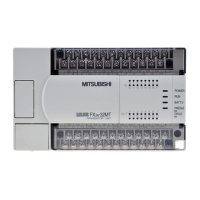REPLACEMENT OF THE MELSECNET/10 (REMOTE I/O NETWORK)
5 - 18
5
5.1.3 Functional Comparisons
(1) A/AnS series
: Compatible, : Partial change required, × : Incompatible
*1 Use GX Developer.
*2 Use GX Works2 or GX Developer.
(To next page)
Item
Description
Compat-
ibility
Precautions for replacement
A/AnS series
MELSECNET/10 module
*1
Q series
MELSECNET/H module
*2
Cyclic transfer function
Communicating with
I/O module
Performs communications with the I/O module of the
remote I/O station using X/Y (LX/LY).
Communicating with
special function
module
Performs communications with the special function
module of the remote I/O station using X/Y (LX/LY) and
B/W (LB/LW).
Data link stop/restart
function
Stops cyclic transmission temporarily with GX Works2 or
GX Developer.
Transient transmission function
N:N communication
function
Communicates only when communication requests are
issued between each stations.
(Communication using dedicated link instruction and GX
Works2/GX Developer.)
ZNFR instruction and ZNTO
instruction cannot be used.
Change them to REMFR
instruction and REMTO
instruction.
Routing function
Performs transient transmission to other stations of which
network No. are different.
Reserved station function
Treats the stations, which are to be connected in the
future, as reserved stations.
By specifying the stations, which are not connected, as
reserved stations, communication error does not occur.
I/O assignment function Sets the module configuration of the remote I/O station.
Set the function with the PLC
parameter of the remote I/O
module.
Extension functions
Constant link scan
function
Keeps link scan time constant.
Multiplex
transmission function
Performs high-speed communication using duplex
transmission path (forward loop/reverse loop).
Return sequence
station number
setting function
Sets the number of stations that can return to system
during one link scan.
ZNFR/ZNTO
instruction access
number setting
function
Sets the number of transient transmissions (a total of
entire one network) that can be executed during one link
scan.
The number of transient
transmissions differs depending
on the total number of slave
stations. The number of
transient transmissions per
slave station is equal.

